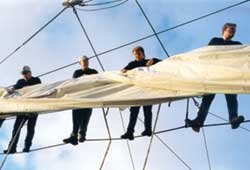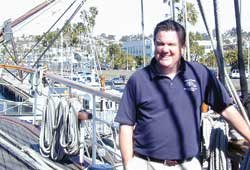YuYu interview Michael Shanahan
 |
| —— Everybody who’s ever been by the embarcadero has seen the Star of India. It’s one of our landmarks. When did she come to make San Diego her home? Well your right, the Star of India has become a San Diego icon for everyone that has been here, locals or visitors; they all know the Star of India. It’s immediately identifiable with San Diego and has been since she arrived here in 1927. —— She’s been here longer than most of us! What’s the story behind how and why she actually came here nearly 80 years ago? 
San Diego’s Star of India in her element, is the world’s oldest active ship! © Randall McLauchlan
Well, she was due to be scrapped up in Oakland, but before that happened a group of San Diegans led by Harry Wegeforth, the man who founded the San Diego Zoological Society, rescued her and brought her to San Diego. They were looking to establish another attraction on San Diego’s waterfront. They wanted to turn the Star of India into an aquarium. The idea was to put a windjammer on the waterfront, enclose it in rip-rap and put aquarium displays inside the ship and around the ship. There was never any conscious decision by anyone that said, “We’ve got to preserve this particular ship for this particular purpose.” It was just a matter of them finding something that served their purposes. By the time she got here it was late 1927 and before they could move too far forward with their plan the stock market crashed, which led to the Great Depression, followed by World War II. So the ship basically sat here and languished for many years. During WWII the tops of the masts were dismantled, as they were considered a hazard to aviation at the time, and it wasn’t until the 1950’s that another group of local people got inspired to go ahead and restore it. Throughout the years she as always open to the public as an attraction, even though it was a deteriorating dilapidated eyesore of an attraction. —— I think a lot of people that come by now may take for granted that San Diego and the embarcadero have always been this vibrant and growing area. I imagine it has probably changed quite a bit, what was it like? 
© Dale Frost
Well, the attitude towards the waterfront has turned 180°since the late nineteenth century, not just here in San Diego, but throughout the world. The waterfronts were the dumping grounds. Your industry was on the waterfront and the fishing fleet was here; there were tuna processing plants, canneries, shipyards and a host of others. Not to mention, our sewers dumped right into the harbor…it was a nasty place. No one had the feeling, like now, that they wanted to preserve a pristine bay—nobody wanted to live here. It just was not a desired location… tragic people lived near the water. Of course, now it’s completely different. In some ways the Star of India coming here was a recognition early on that tourism was going to be a substantial part of our economy. Now most all of the industrial and military uses for the bay are south of the bridge and the north embarcadero, with the addition of the Midway, the cruise ships, and the rebirth of Little Italy, has become one of the prime attractions in all of San Diego. —— I understand that she’s currently the world’s oldest active ship. When did she set sail for the first time? She started life in the Ramsey Shipyard, in the Isle of Man, in 1863, under the name Euterpe, after the Greek goddess of music. She’s 212 feet long, got a beam of 35 feet and she weighs in at 1318 tons. Originally, she was a full-rigged ship and later new owners, the Alaska Packers Association, rigged her down to a barque around the turn of the century. Early on she served as a cargo ship, then from 1870 as an emigrant ship and later as an Alaska Packer ship before she was laid up 1923. As I mentioned before, her restoration began in the ’50s, but began in earnest in the ’60s and then she finally sailed again in 1976, for the first time since the twenties. —— What is so unique about the Star of India? There is nothing unique about this ship at all, which is one of the most unique and remarkable things about it! There is no rhyme or reason for this ship to have survived. It wasn’t involved in any famous historical event, there was no great treaty signed onboard, no nations surrendered here, and she wasn’t part of any battles or a warship of any kind. She was an everyday work-ship—not the type of ship that usually gets preserved. So the fact that she was preserved is absolutely remarkable! While she wasn’t involved in any one historic event, she is directly tied to one of the most significant ongoing events in world history—the emigration of people across oceans. Nearly everyone one of us living in the United Sates can trace their ancestors back to someplace other than here. When Europeans started on getting on sailing ships, beginning in the 15th century and culminating in the late 20th century, and spreading out around the world—that changed the face of the entire world. Before these sailing emigrant ships, we were all isolated. Thanks to this ship, and thousands of ships like her, all that changed. The Star of India herself has made 21 trips around the world as an emigrant ship, taking emigrants from England to New Zealand. —— What do you think enabled her to survive for so long while most of her contemporaries are no longer with us? Well, there are some anomalies to the ship that, to a certain degree, explain why she still exists. Certainly, her construction of iron is one of the reasons. If she were constructed of wood or steel she probably wouldn’t still be with us today. Wood rots and steel rusts, but iron neither rusts nor rots at the rate steel or wood does…even though you can hear them banging away replacing the decks right now! Also, because the ship was one of the very first iron ships built, and because they hadn’t built iron ships previously, she’s framed like a wooden ship, meaning the framing is relatively close together—much more so than later ships. So she is over built. Because she is and made of iron, it helped her to survive, but more than anything it’s just a coincidence. Interestingly enough, while many ships were called into action during the world wars, she never was—just another reason why she’s still here with us. Today, out of the literally thousands of ships just like this one, only handful are still left and only one is this old and still sails—the Star of India. —— Has there always been a soft spot here for the Star of India? It’s hard to say. I think the process of becoming a community icon takes time. Now, certainly if she were not to be in San Diego anymore, she would be missed. To give you an example, from time to time there have been some discussions about moving the Maritime Museum to various other parts of the harbor. Each time it comes up they say, “We want you to move the Maritime Museum, but you’ve got to leave the Star of India.” (laughing) What they don’t fully understand is that it is a package deal—the Star of India is part of the Maritime Museum. Sometimes people think that somehow she is a stand-alone object that sort of preserves herself. In fact, she requires a rather complex organization to keep her going. Anything this old, sitting in salt water, exposed to the elements, takes a lot of work. Boats are always in a constant state of decay and that is especially true for older ships. We could not operate the museum and particularly keep the Star of India in the shape that it is in without our volunteers. They do the lion’s share of the work and they work their tails off all year long, both preserving it and training on how to sail the ship. —— When she’s sailing, what type of crew does it take? 
It’s always taken a courageous crew with nerves of steel to man this ship. © Maggie Piatt-Walton
Our actual sail crew is going to be between 50 and 60, including the captain. We don’t actually need that many hands; this ship was sailed in the 19th century by 18 people, because it was a business and this ship was going to make money for its owner, so they didn’t want to pay more people then they had to. They weren’t particularly concerned with safety the way that we are today. We want to be safe, but we also want to give as many people an opportunity to sail the ship as possible. That’s their reward for having worked so hard to maintain the ship and train all year long. They have to pass physical and written tests just to maintain the ship and then if they put in enough hours maintaining and training, then they get an opportunity to sail. —— Having been on the Star of India when it’s underway, what’s the feeling? It is an absolutely amazing experience! We’re towed out, because there is no onboard power, and you can feel the ship more or less being tugged, but the feel of this ship when the towline is dropped and she goes under sail power is truly amazing. You can really feel the difference as the ship rises up and is taken by the wind and she gets into her element. A couple of times I’ve been on board and we’ve had really good wind and for a ship this long to be heeled over 10° or 12° is an amazing thing. Then, being able to watch the crew in action is fascinating for people; they work so hard all year. To watch them going through their paces, it’s almost like a little show that they put on. They literally work all year long for this one weekend to go out and sail her. Typically she gets underway once a year. The Star of India, along with most of our other ships, kept sail-ready. Not only is it the best practice in terms of maintaining the ships in the best shape possible, but it preserves certain skills that otherwise might die off. —— As you said, the Star of India is just one of many of the Maritime Museum’s exhibits, what are some of the others? 
Volunteers are the backbone of the Star and the fortunate ones are rewarded with a taste of how things used to be. © Maggie Piatt-Walton
We are always growing. The core of our museum, as it has been for many years, has been the Berkeley ferry boat, the 1898 steam ferry which hosts our offices, gift shop and many special events. We’ve got Medea, our 1904 steam yacht, and a beautiful example of the great age of consumption, when well to do families had to have a big steam engine. She actually was called into action by the Navy and served in both WWI and WWII. In 2002, we added California, which is a replica of a Revenue Cutter, the Revenue Marine being the forerunner of the Coast Guard. She was built in 1984, and what’s nice about having her is it allows us to offer sailing programs on a regular basis. Being a replica it’s a fully licensed Coast Guard passenger vessel with all the onboard amenities that the Star of India doesn’t have. The Star, when it is sailed, is essentially a 19th century ship and we sail it that way; there’s no modern navigation, no engine or modern amenities. Just outside, we’ve got the H.M.S. Surprise a replica of an 18th century Royal Navy Frigate, which was used in the Academy Award winning Master and Commander: The Far Side of the World with Russell Crowe and we’ve also got a B-39 Soviet attack submarine or Foxtrot, which is our latest addition. The Foxtrot is a veteran of the Cold War and they were assigned to the Soviet pacific fleet. They were involved in chasing around US and NATO vessels and more than one ex-submariner or sub-hunter has done a double –take to see a Foxtrot sitting in our harbor—the heart of America’s military might in the pacific. Here, you can go aboard, look through the periscope and site an American aircraft carrier across the way at North Island. —— I know in addition to the different ships, you also host a number of educational and social events, can you tell me a little bit about some of them? 
Michael on deck the Star of India making sure everything is shipshape.
I’m very pleased to say that “Movies Before the Mast”, our summer movie program in which we show movies on the sails, is in its 14th season and it’s become somewhat of a San Diego tradition. Not so long ago the N.Y. Times Travel Section made mention of us, which I thought was great. When you’re recognized by the NY Times, that’s a great feather in your cap. It’s three weekends in both July and August; Friday nights are date nights and Saturdays are more family oriented. It’s a great way to enjoy the ambience of the harbor and the ship. Another one of our really popular events are the family sleepovers on the Star of India. People come out at 3 o’clock on Saturday and leave 9 o’clock the next morning, and they are taken on an imaginary voyage as if they were emigrants to New Zealand in the 19th century-and the people just love it! We’ve also got our “adventure package admission” and that includes a day-sail, which I think is the best value in town. You get to come down and visit the museum and all the ships and take a 3-hour adventure sail on California that afternoon. We call them adventure sails, as opposed to harbor excursions, because we encourage people to become actively involved in sailing the ship. We try to teach them how things are done, and they can haul a line, they can take a turn at the helm and really get a taste of what its like to sail. (03-01-2006 issue, Interviewed by Terry Nicholas) |

